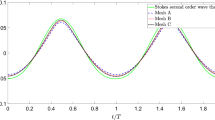Abstract
Waves can have a significant impact on nearshore currents. A three-dimensional baroclinic current model including the influence of waves is presented for shallow water areas from Navier-Stokes equations. It has been found that the effects of waves on currents can be expressed in terms of the momentum flux by waves. The model uses non-orthogonal curvilinear coordinates in the horizontal directions and a Sigma coordinate in the vertical direction so that it can be more reasonably applied in estuarine and coastal regions.
Similar content being viewed by others
References
Longuet-Higgins, M. S., Stewart, R. W., Changes of in the form of short gravity waves on long waves and tidal currents, J. F. M., 1960, 8: 565.
Dalrymple, R. A. et al., Wave-current interaction models for rip currents, J. G. R., 1978, 83(c12): 6063.
Southgate, H. N., A one-dimensional model of wave-current interaction, Coastal Hydrodynamics, ASCE, 1987, 79–82.
Southgate, H. N., A nearshore profile model of wave and tidal current interaction, Coastal Eng., 1989, 13: 219.
Zhang Dongsheng et al., The numerical simulation of nearshore currents in the Guanhe mouth, Oceanologia et Limnologia Sinica (in Chinese), 1988, 4.
Cao, Z. D., Numerical simulation of sediment stirred by waves and transported by tidal currents, Acta Oceanologica Sinica (in Chinese), 1993, 15(1): 107.
Yan Yixin, The mathematical model of the interaction between waves and currents in the tidal estuary, Coastal Eng. (in Chinese), 1989, 47–55.
Ding Pingxing et al., The research of sediment diffusion model due to currents and waves at tidal flat, The 8th Coastal Engineer Academy Forum (in Chinese), Beijing: Ocean Press, 1997, 754–761.
Longuet-Higgins, M. S., Stewart, R. W., Radiation stress and mass transport in gravity waves, with application to surf beat, J. F. M., 1964, 13(4): 529.
Wei Shoulin et al., Suspended sediment transport by the action of combined waves and currents, The Dynamical Sediment Progress of Nearshore in Shandong Peninsula (in Chinese), Qingdao: Ocean Univ. of Qingdao Press, 1992, 149–170.
Cao Z. D., Wang Guifen, Three-dimensional numerical simulations of tidal, waves and sediment, The 7th Coastal Engineer Academy Forum (in Chinese), Beijing: Ocean Press, 1993, 584–590.
James, K. L., A three-dimensional ocean circulation model with wave effects, Estuarine and Coastal Modeling, Proc. of the 5th International Conf., 1997, 585–600.
Ding Pingxing et al., A three-dimensional mathematical transport model for suspended sediment by waves and currents, Progress in Natural Science, 2001, 11(1): 1.
Mellor, G. L., Yamada, T., Development of a turbulence closure model for geophysical fluid problems, Rev. Goephys. Space Phys., 1982, 20.
Author information
Authors and Affiliations
Corresponding author
Rights and permissions
About this article
Cite this article
Ding, P., Zhu, S. & Kong, Y. A three-dimensional baroclinic current model with wave effects. Sc. China Ser. B-Chem. 44 (Suppl 1), 92–98 (2001). https://doi.org/10.1007/BF02884814
Received:
Issue Date:
DOI: https://doi.org/10.1007/BF02884814



